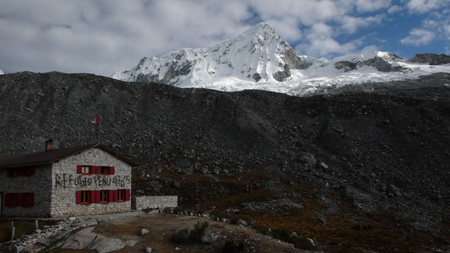
|
|
Going to Church. |
A strong grip – Malevolent forces – Pishtacos – Bloody Illustrations
Sometimes when I read a book it gets a hold on me and I can’t stop thinking about it. About three weeks ago I read “A Death in the Andes“, by Mario Vargas Llosa, and the themes explored by the Peruvian author have had quite an impact on me. The novel is set in 1980’s Peru, at a time when the Sendero Luminoso or Shining Path was active.
The plot revolves around Corporal Lituma, a man from the coastal city of Piura, who has been sent on assignment deep into the Andes. In the Andes Lituma is as much of an outsider as one of us would be and as readers we immediately sympathize with his position. Vargas Llosa’s Andes are mysterious, malevolent, and filled with superstition and danger. Lituma’s vexing problem is the mysterious deaths of three individuals – have they been killed by the Shining Path or is there some other deeper and more malevolent force behind the killings?
Through brief vignettes Vargas Llosa introduces us to the brutality of the Maoists or “terrucos” as they are called in the book. But he also introduces us to the old and superstitious culture of the Andes, a culture of witches and vampires. We learn of Pishtacos, evil beings that kill humans to render their fat, which is then used for various purposes like fine soap and machine oil. It is this latter imagery that is particularly disturbing and troubling; as bad as the terrucos are they can at least be understood as brutal thugs.

|
|
In the Andes. |
During his trying times in the Andes Lituma’s sole source of escape is a long and detailed love story related to him by his subordinate, Tomasito. To escape the madness of the mountains Lituma hungers for each new episode that Tomasito recounts. The ancient culture of the Andes imbues the mountains with Gods, each demanding his share of human sacrifice, as do the troops of terrucos wandering the countryside. Lituma is surrounded with a world he cannot understand.
After reading this book I have become increasingly revolted by religion and the bloody illustrations it uses to keep the masses faithful. Images of Isaac squealing under Abraham’s knife, San Lorenzo posing with his grill, and Jesus in his hyper-realistic agony all evoke the ancient Andes and its superstitions. They are no longer a quaint custom to be examined with a smile, but a nameless primordial horror.
New additions to the website:
• Slideshow on Minas Gerais, Brazil.
Before the novel, I think it was Vargas-LLosa who wrote an article about the murder of some journalists in the Andes, which was fascinating.
Hey Shreesh,
My wife and I spent a couple weeks in Peru for our honeymoon a couple months back and I also read ‘Death in the Andes’ while I was there. Just though I’d say hello, and hope your guys are having fun.
Ray (daPitbull from the blue forum)
Hi Brennan and Ray,
The most disturbing aspect about the book is that it is loosely based on events that have actually occurred. Being in the Andes, in these locales, it is certainly not had to imagine the events unfolding.
The combination of superstition and isolation yield mysterious monsters – if you believe strongly enough they come to life and become real.
hello!!i just write half hour ago, thinking you probably pased from Buenos Aires, as far as I see it you arenot ? ok sorry my english ,but Im heppy to know about you again ,now if you are in chile(valparaiso) , it is the Rally Dakar thru there today !!! I really hope you look to get in touch with me so i can show you the city of Rosario , de Santa Fe and sourrounding areas!!! por favor escriban asi les puedo ayudar, si quieren!!! besos y sigan bien. Fabio
Shreesh, you should read the original article – it was chilling. Vargas-Llosa’s written some great novels and short-stories – quite accessible in Spanish. On the whole “vampire” thing: I remember reading an article (might have been in Granta travel) about a similar thing in Indonesia, where the Western author, arriving in a village near night-fall was thought to be a vampire, and had a bit of bother convincing the armed villages otherwise.
Hi Brennan,
I will try to look up the original article – do you happen to remember in which magazine or journal you read it?
Twilight is always a bad time to arrive in a new place; neither day nor night it is the time when many accidents occur.